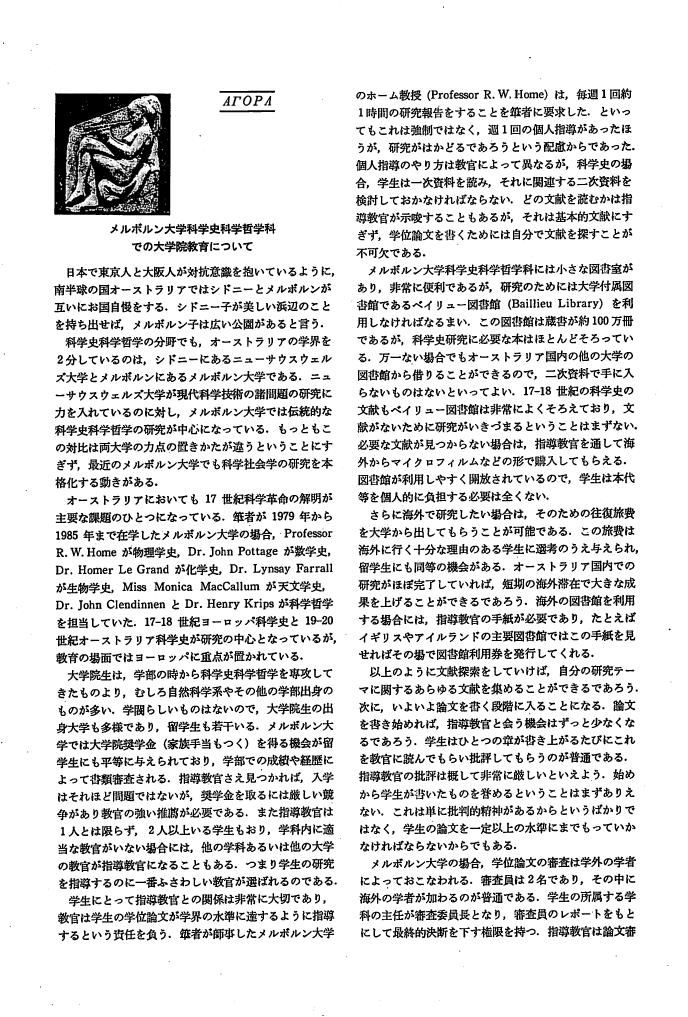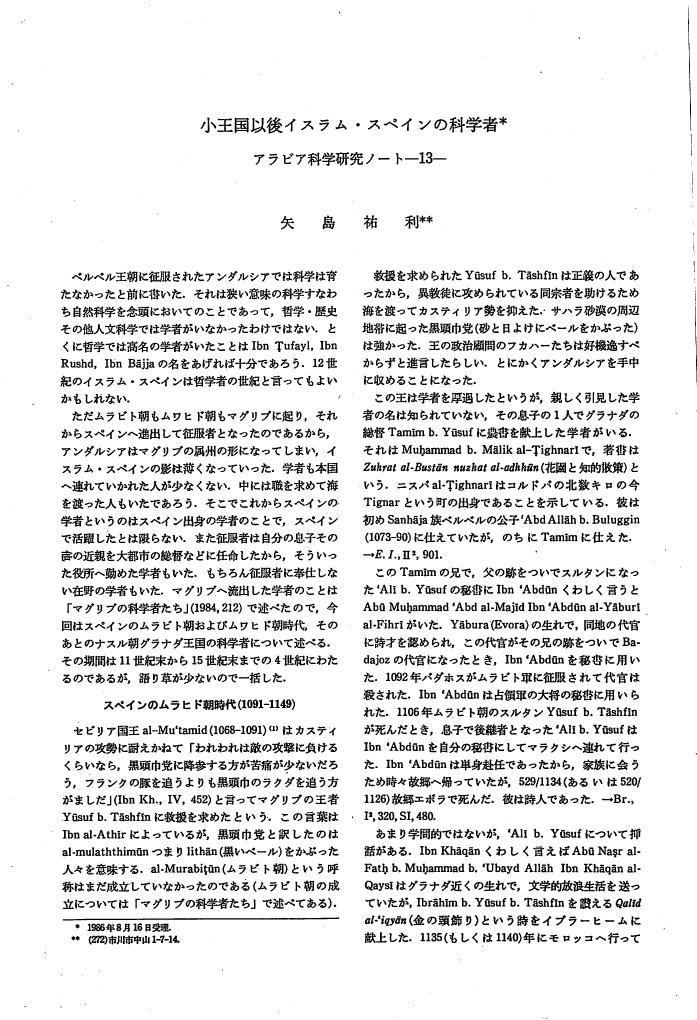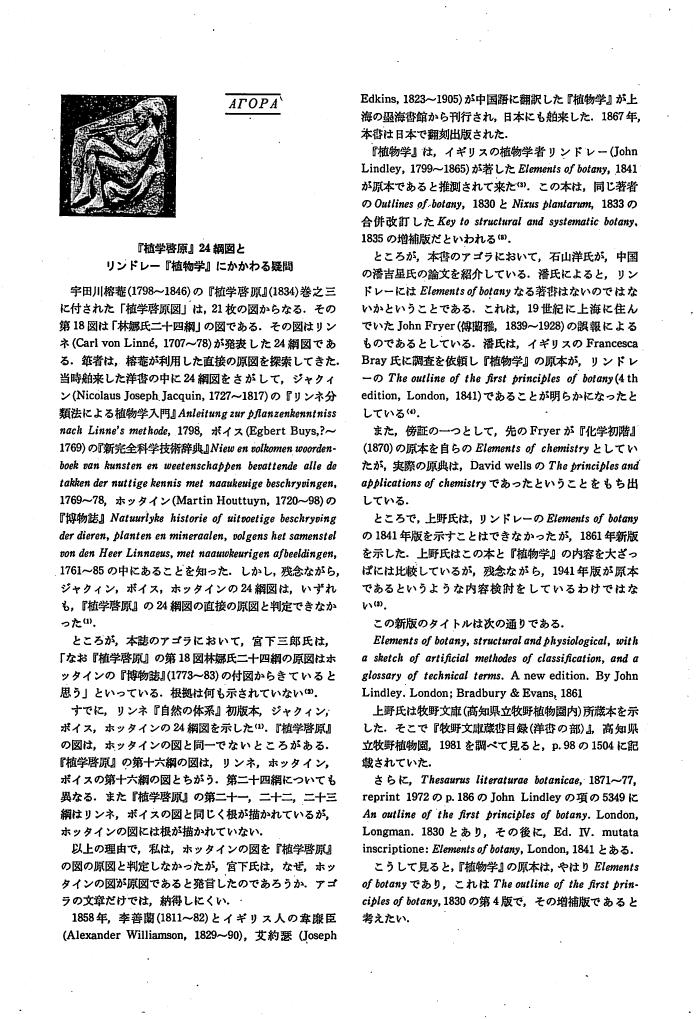1 0 0 0 OA 春秋時代(B. C. 722〜479)の日食 その他天文記事の再検討
- 著者
- 斉藤 国治 小沢 賢二
- 出版者
- 日本科学史学会
- 雑誌
- 科学史研究 (ISSN:21887535)
- 巻号頁・発行日
- vol.26, no.161, pp.24-36, 1987 (Released:2021-09-22)
Chun-Qiu (春秋) or the Spring and Autumn Annals is a chronicle of Luo (魯), a state of Ancient China, covering the period from 722 bc to 479 bc. It includes astronomical records such as solar eclipses, comets, planetary motions etc.. Among these data, solar eclipses, 37 in total, have been examined by many scholars to make clear the calendar of the period. Conclusion is that 33 among the above-mentioned 37 eclipses can be identified with those listed in Oppolzer's "Canon der Finsternisse", while the remaining four have been abandoned as doubtful because no eclipses can take place on the dates of the records. The present paper shows that two of the hitherto-doubted data (# 15 and # 22 of the Chun-Qiu eclipse numbers) can be turned out to be real eclipses solely by changing the year-numbers in the documents as follows. (1) In case of the # 15 eclipse, the original document says, "On a kui-mao day (癸卯) in the sixth month of the seventeenth year of Lord Xuan (宣公) ,a solar eclipse occurred" Simply change the "seventeenth" to the "seventh" in the document, then this record correspnds to Oppolzer's No. 1445 partial eclipse which was visible as much eclipsed as 0.36 in Qufu (曲阜), capital of Luo, in early morning on May 8, in 602 BC. (2) In case of the # 22 eclipse, the document says, "On the first day and geng-chen (庚辰) day in the tenth month of the 21st year of Lord Xian (襄公) a solar eclipse occurred." This hitherto-doubted record recovers its righteousness only by changing the "21 st" to the "26 th". Then the record is identified with the eclipse of Oppolzer's No. 1588 which was seen in Qufu in the evening of October 23, in 547 BC. At this time the sun set at 17:23 while being eclipsed as much as 0.26. (3) Julian days of these re-located eclipses are kui-mao and geng-chen, the same as in the originals. This cannot be a mere coincidence since probability of coincidence by chance between the sexagesimal dates is as small as 1/60. (4) The discovered misprints of dates may have been originated from any disorder of the bamboo tablets or from mistranscriptions in the later times. Anyway, addition of these two eclipses will be useful in order to study the calendar system of the Chun-Qiu Period.
1 0 0 0 OA 自営館時代の石原純
- 著者
- 松尾 重樹
- 出版者
- 日本科学史学会
- 雑誌
- 科学史研究 (ISSN:21887535)
- 巻号頁・発行日
- vol.26, no.161, pp.37-40, 1987 (Released:2021-09-22)
1 0 0 0 OA 第二次世界大戦期における原爆の物理学的研究と核兵器工学の成立
- 著者
- 山崎 正勝
- 出版者
- 日本科学史学会
- 雑誌
- 科学史研究 (ISSN:21887535)
- 巻号頁・発行日
- vol.25, no.160, pp.225-234, 1986 (Released:2021-09-22)
The first idea of atomic bomb proposed by E. Fermi and, especially, L. Szilard, who was the real writer of Einstein's letter to President F D Roosevelt in 1939, was shown to be based on a fast neutron chain reaction in normal uranium which was later proved to be inert for fast neutrons At that time such an idea was also proposed independently by L. Peierls in Britain, but he soon abandoned it because of its great critical mass estimated theoretically by himself. The large scale enrichment of uranium was at first pursuited to produce a thermal nuclear chain reaction (the nuclear reactor) effectively. This stream was thus independent of that for the construction of the bomb at the early stage Those two streams above were, however, joined together in 1940 by O. Frisch and Peierls in their memorandum on a super bomb, which first showed the technological principle of atomic bomb based on the fast neutron chain reaction in pure uranium 235 In contrast to these two streams in the U.S. were kept divisitive by compartmentalization of information adopted by V.Bush, the chairman of NDRC. The idea of the Frisch-Peierls memorandum is studied in detail in comparison with the MAUD reports, the British official reports, completed in the summer of 1941. It is shown that the influence of the British research on the atomic bomb was the most important factor for the full start of the development of the bomb in the U.S. in the autumn of 1941. The problem on independence between NAS report of November 6,1941 and the MAUD reports is discussed.
1 0 0 0 OA 明治中期の少年雑誌における科学ジャーナリストの役割 ―中川重麗の場合―
- 著者
- 東 徹
- 出版者
- 日本科学史学会
- 雑誌
- 科学史研究 (ISSN:21887535)
- 巻号頁・発行日
- vol.25, no.160, pp.245-254, 1986 (Released:2021-09-22)
The juvenile magazine Shonen'en was the first to put in articles on science and technology in Japan. As it was well received, many magazines just like Shonen'en were published one after another. Shigeaki Nakagawa was one of famous journalists who wrote the articles on science in these juvenile magazines. He learned German from R. Lehmann who was a teacher of Ogakusha in Kyoto. He learned physical sciences through the learning of German When he was a teacher of Kyoto Normal School, he wrote many science textbooks on referring to F Schoedler's Das Buch der Natur. Then he resigned his post as a teacher, and he was engaged on a staff of the education magazine He published a magazine Shonen'en with Teisaburo Yamagata in 1888. Articles which he wrote in juvenile magazines incorporated a variety of ideas designed to arouse interest in science and technology. His articles had a great influence on the popularization of science to the youth. Enlightenment of science to the youth became gradually performed by specialists of science The main medium of science to the youth changed from the juvenile magazine to the book. So he ceased to play the role of popularizer of science to the youth.
1 0 0 0 OA 動力技術の発達法則についての石谷説の再検討
- 著者
- 門脇 重道
- 出版者
- 日本科学史学会
- 雑誌
- 科学史研究 (ISSN:21887535)
- 巻号頁・発行日
- vol.25, no.160, pp.255, 1986 (Released:2021-09-22)
1 0 0 0 OA 『七ー雑報』の「理学史伝の概略」
- 著者
- 島尾 永康
- 出版者
- 日本科学史学会
- 雑誌
- 科学史研究 (ISSN:21887535)
- 巻号頁・発行日
- vol.25, no.160, pp.258-260, 1986 (Released:2021-09-22)
1 0 0 0 OA バビロニア数学における容量単位silàの特殊用法とVAT8522の解釈について
- 著者
- 室井 和男
- 出版者
- 日本科学史学会
- 雑誌
- 科学史研究 (ISSN:21887535)
- 巻号頁・発行日
- vol.25, no.160, pp.261-266, 1986 (Released:2021-09-22)
A Babylonian capacity unit "silà" was also used as a unit of "thickness" of a log. Neugebauer and Sachs almost clarified the meaning of the silà through a study of YBC 4669, 8600, that is, "x silà of a log" means a capacity of a circular cylinder whose height is 6 šu-si But the contents of VAT 8522 Vs.I which treats the thickness of a log remains obscure despite their efforts. I find a clue to the solution to the calculation in VAT 8522 Vs.I in the expression of relation 1 silà=(6 šu-si)³=(0;l ninda)³ and the number 1;20 which is hidden in line (6a) of the text. Neugebauer suggested that 1;20 was a "normalizing constant" and I regard this as a proportional constant between the area of a square and the area of its inscribed circle in case of a certain equivalent transformation of a prism into a circular cylinder The process of the calculation made by a Babylonian scribe in a roundabout way is as follows. In the first place he takes the cubic roots of 1,4 silà and 8 silà, and gets 4 dal,2 dal respectively (unit; 6 šu-si). Namely he transforms each circular cylinder into a cube retaining the same volume. Consequently "dal" is a side of the cube and not a diameter here. Next after taking the average of the dais, an assumed circular cylinder which is inscribed in the averaged cube is introduced and the area its base is calculated by a usual formula. This "whole area" is multiplied by 6,40 ( = 5,0 * 1;20) to get the true volume. At this point Babylonian "normalization of a log" has been completed. The last calculation, which is omitted in the text is, in my judgement, as follows. By dividing the volume by the area of the base of the normalized log, the length of the log is obtained, and then by multiplying it by 9/10 the length of the log which should be cut down is obtained.
1 0 0 0 OA 紹介
- 出版者
- 日本科学史学会
- 雑誌
- 科学史研究 (ISSN:21887535)
- 巻号頁・発行日
- vol.25, no.160, pp.267-282, 1986 (Released:2021-09-22)
1 0 0 0 OA 銅鐸の動物図柄と延喜式神名帳について(アゴラ)
- 著者
- 富田 徹男
- 出版者
- 日本科学史学会
- 雑誌
- 科学史研究 (ISSN:21887535)
- 巻号頁・発行日
- vol.25, no.160, pp.283-284, 1986 (Released:2021-09-22)
1 0 0 0 OA アゴラ メルボルン大学科学史科学哲学科での大学院教育について
- 著者
- 伊藤 雄志
- 出版者
- 日本科学史学会
- 雑誌
- 科学史研究 (ISSN:21887535)
- 巻号頁・発行日
- vol.25, no.158, pp.123-124, 1986 (Released:2021-04-05)
1 0 0 0 OA 日本の金漆
- 著者
- 寺田 晁
- 出版者
- 日本科学史学会
- 雑誌
- 科学史研究 (ISSN:21887535)
- 巻号頁・発行日
- vol.25, no.159, pp.129-136, 1986 (Released:2021-04-03)
1 0 0 0 OA 村井中漸び「算学系統・弧背密術」について -特に関孝和に関する記述を中心に
- 著者
- 小林 龍彦 田中 薫
- 出版者
- 日本科学史学会
- 雑誌
- 科学史研究 (ISSN:21887535)
- 巻号頁・発行日
- vol.25, no.159, pp.137-141, 1986 (Released:2021-04-03)
1 0 0 0 OA 小王国以後イスラム・スペインの科学者 アラビア科学研究ノート-13-
- 著者
- 矢島 祐利
- 出版者
- 日本科学史学会
- 雑誌
- 科学史研究 (ISSN:21887535)
- 巻号頁・発行日
- vol.25, no.159, pp.142-145, 1986 (Released:2021-04-05)
1 0 0 0 OA 技術史の時代区分についての石谷説の再検討
- 著者
- 門脇 重道
- 出版者
- 日本科学史学会
- 雑誌
- 科学史研究 (ISSN:21887535)
- 巻号頁・発行日
- vol.25, no.159, pp.146-150, 1986 (Released:2021-04-05)
1 0 0 0 OA 数学粘土板VAT672の一所見
- 著者
- 室井 和男
- 出版者
- 日本科学史学会
- 雑誌
- 科学史研究 (ISSN:21887535)
- 巻号頁・発行日
- vol.25, no.159, pp.151-154, 1986 (Released:2021-04-05)
1 0 0 0 OA アゴラ 『植学啓原』24網図とリンドレー『植物学』にかかわる疑問
- 著者
- 矢部 一郎
- 出版者
- 日本科学史学会
- 雑誌
- 科学史研究 (ISSN:21887535)
- 巻号頁・発行日
- vol.25, no.159, pp.163-164, 1986 (Released:2021-04-05)
1 0 0 0 OA 動力史の時代区分における石谷説の再検討
- 著者
- 門脇 重道
- 出版者
- 日本科学史学会
- 雑誌
- 科学史研究 (ISSN:21887535)
- 巻号頁・発行日
- vol.25, no.157, pp.46-49, 1986 (Released:2021-04-05)
- 著者
- 室井 和男
- 出版者
- 日本科学史学会
- 雑誌
- 科学史研究 (ISSN:21887535)
- 巻号頁・発行日
- vol.25, no.157, pp.50-52, 1986 (Released:2021-04-05)
1 0 0 0 OA 『星界の報告』におけるガリレイの誤謬
- 著者
- 西村 秀雄
- 出版者
- 日本科学史学会
- 雑誌
- 科学史研究 (ISSN:21887535)
- 巻号頁・発行日
- vol.25, no.158, pp.65-73, 1986 (Released:2021-04-05)
1 0 0 0 OA 阿部良夫の科学史学上の業績とその影響
- 著者
- 高田 誠二
- 出版者
- 日本科学史学会
- 雑誌
- 科学史研究 (ISSN:21887535)
- 巻号頁・発行日
- vol.25, no.158, pp.74-82, 1986 (Released:2021-04-05)















